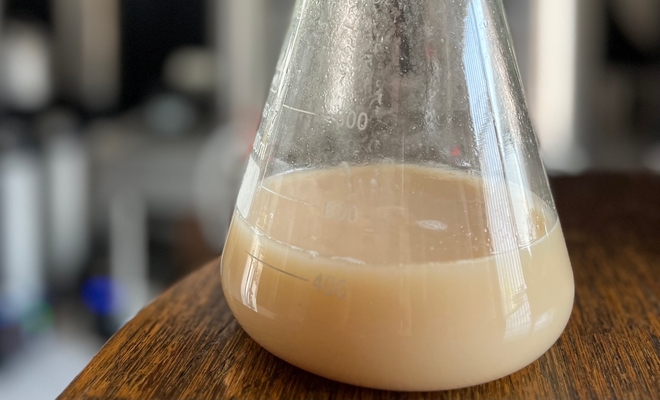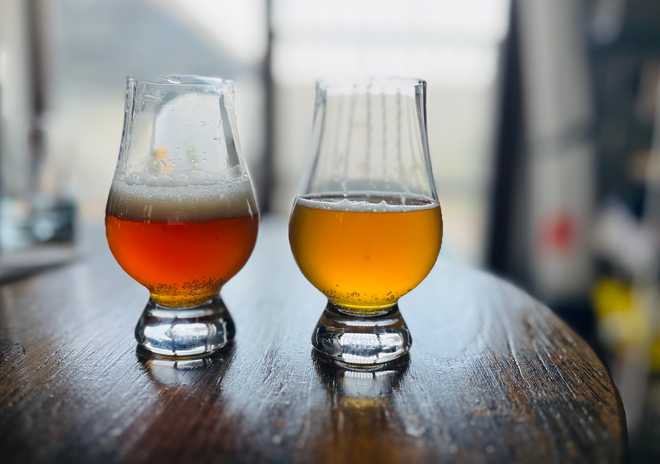Brewing a Country's First Local Beer

In April, I successfully captured wild yeast from a local fruit tree that somehow grows well here in the Sahara. Looking at it under a dusty, neglected microscope in the U.S. Embassy health unit, I ventured a guess that it was yeast and not Lactobacillus though I would have been happy with either outcome. Last month, I brewed a pilot batch of beer with the newly wrangled wild yeast and this post describes how it turned out.
YEAST WRANGLING RECAP
There are three methods for capturing yeast: from the air, off the skin of fruits and vegetables, and from swabbing a yeast-culture wherever you can find it–say, from bottle conditioned beer or the surface of your unsuspecting local brewer’s fermenter. With the air quality in this part of West Africa typically in the triple digits, I failed (twice) to capture yeast from the air. I hit single-cellular pay dirt from the skin of a mini orange tree that somehow grows well in our literal backyard.
It's either dust or yeast
I took about a pencil eraser-size amount of yeast and propagated it up to a half liter starter for a one gallon pilot batch. It’s pretty difficult to over-pitch yeast and despite having a good idea of the yeast's vitality, I wasn’t sure how they’d perform.
SHOT IN THE DARK
The whole point of this exercise was to move everything out of the way to focus on the flavors imparted by the wild yeast. To that end, I decided to make the most basic beer I could think of: a single malt and single hop (SMaSH) ale. Given it’s a one gallon batch, I decided to just use dry malt extract and just make the thing in my five liter flask I typically use for large lager yeast starters. Like I do with Saisons and farmhouse ales, I kept the amount of hops in the boil low to keep the IBUs around 20–again,to get a proper BU:GU ratio while letting the yeast shine through most of all.
Without knowing what temperature the yeast might perform best, I just kind of squinted, aimed at the middle of the dart board, and landed on…room temperature. I was torn on whether higher temperatures might produce interesting flavors like a Saison or if playing it safe in the low/middle range of an ale yeast was the way to go. In the end, I decided to split the difference: brew the beer under pressure in a one gallon keg at room temperature. That allowed me to brew the beer quicker (particularly if the yeast might underperform at temps in the low/mid range for ales) and not worry too much about negative off-flavors from a slightly higher fermentation temperature.
The final product had the following stats:
OG: 1.053
FG: 1.013
IBU: 20
ABV: 5.3%
A TALE OF TWO BEERS
When the beer reached final gravity, I carbonated it and let it condition for a few days before I couldn’t wait any longer to try it. The result was a crisp, clean ale very similar to what you’d expect from US-05. That surprised me–don’t get me wrong, I think it’s a happy day when you can add another clean-fermenting ale yeast to your vault but I was expecting more fruit or barnyard funk.
Left: Tap Tap Haitian Lager (for comparison), Right: ale from local yeast
Fast forward three weeks (the only way I could not touch this batch was to go on vacation on another continent for almost a month). Unsurprisingly, the beer had aged very well and it became a crowd favorite for its short, one gallon life. If the first sip was more or less unremarkable, the last was refreshing and intriguing. The beer was absolutely more complex after conditioning and there were hints of interesting, peppery flavors imparted by the yeast. There’s more to this yeast and I plan to experiment with where its happy fermentation place lies.
EXPLORATION THROUGH FERMENTATION
This batch showcases the Lost Nomad concept perfectly: we allow our customers to explore variations of beer styles based on how cultures around the world brewed them. I’d be hard pressed to think of a better way for a country to influence a beer than with the yeast sourced directly from within its borders. This also raises an interesting opportunity: there are a lot of places that have a lot of local wild yeast doing great things but not specifically in beer.
Part of my three weeks away was spent in southern Spain where spontaneous fermentation from yeast found on grape skins is the standard process to produce great wine. After kicking myself for forgetting my yeast wrangling kit, I realized not only can we showcase how beers are brewed around the world, but we could also explore how beers could be brewed if that part of the world chose to do so with their local ingredients. Some places just don’t have a beer culture (yet), so this is an expansion of the Lost Nomad concept that explores what beer could taste like if they did.
Finally, given the situation in this part of West Africa I can confidently say Lost Nomad has brewed the first local craft beer in the history of this country. Yes I’m being deliberately opaque about the country in question, and as a result naming the beer was easy.
Cheers to the [Redacted] Wild Ale. We hope the Local Nomads enjoyed it, we brewed it for them.
